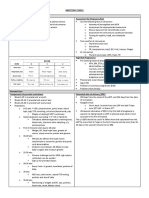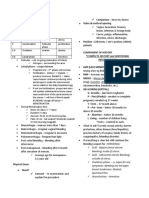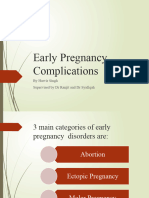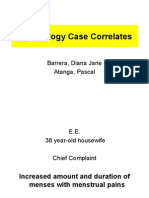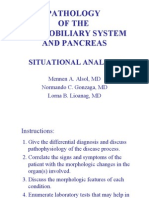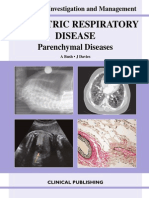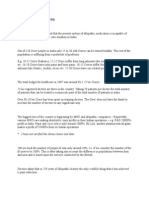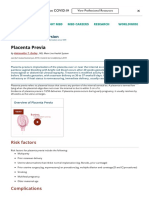Obgyn Mnemonics
Obgyn Mnemonics
Uploaded by
api-3700579Copyright:
Available Formats
Obgyn Mnemonics
Obgyn Mnemonics
Uploaded by
api-3700579Copyright
Available Formats
Share this document
Did you find this document useful?
Is this content inappropriate?
Copyright:
Available Formats
Obgyn Mnemonics
Obgyn Mnemonics
Uploaded by
api-3700579Copyright:
Available Formats
OBSTETRICS/ GYNECOLOGY ASHERMAN:
Acquired Anomaly
MNEMONICS Secondary to Surgery
Hysterosalpingography confirms diagnosis
Endometrial damage/ Eugonadotropic
Post-partum examination simplified checklist
Repeated uterine trauma
Missed Menses
BUBBLES:
Adhesions
Breast
Normal estrogen and progesterone
Uterus
Bowel
Bladder
Lochia
Episotomy
Surgical site (for Cesarean section) CVS and amniocentesis: when performed
"Chorionic" has 9 letters and Chorionic villus sampling performed at 9
weeks gestation.
Miscarriage: recurrent miscarriage causes "AlphaFetoProtein" has 16 letters and it's measured at 16 weeks gestation.
RIBCAGE:
Radiation
Immune reaction Shoulder dystocia: management
Bugs (infection)
Cervical incompetence HELPER:
Anatomical anomaly (uterine septum etc.) Call for Help
Genetic (aneuploidy, balanced translocation etc.) Episiotomy
Endocrine Legs up [McRoberts position]
Pressure subrapubically [not on fundus]
Enter vagina for shoulder rotation
Reach for posterior shoulder and deliver posterior shoulder/ Return head
Forceps: indications for use into vagina [Zavanelli maneuver] for C-section/ Rupture clavicle or pubic
symphisis
FORCEPS:
Fully dilated cervix
0 ["Zero"] CPD
Ruptured membranes Oral contraceptive complications: warning signs
Cephalic or at least deliverable presentation/ Contracting uterus
Episiotomy done/ Epidural done ACHES:
P!ss and S#!t (bladder and bowel empty) Abdominal pain
Chest pain
Headache (severe)
Eye (blurred vision)
Oral contraceptives: side effects Sharp leg pain
CONTRACEPTIVES:
Cholestatic jaundice
Oedema (corneal) Alpha-fetoprotein: causes for increased maternal serum AFP during
Nasal congestion pregnancy
Thyroid dysfunction
Raised BP "Increased Maternal Serum Alpha Feto Protein":
Acne/ Alopecia/ Anaemia Intestinal obstruction
Cerebrovascular disease Multiple gestation/ Miscalculation of gestational age/ Myeloschisis
Elevated blood sugar Spina bifida cystica
Porphyria/ Pigmentation/ Pancreatitis Anencephaly/ Abdominal wall defect
Thromboembolism Fetal death
Intracranial hypertension Placental abruption
Vomiting (progesterone only)
Erythema nodosum/ Extrapyramidal effects
Sensitivity to light Early cord clamping: indications
RAPID CS:
Post-partum haemorrhage (PPH): causes Rh incompatibility
Asphyxia
4 'T's: Premature delivery
Tissue (retained placenta) Infections
Tone (uterine atony) Diabetic mother
Trauma (traumatic delivery, episiotomy) CS (caesarian section) previously, so the funda is RAPID CS
Thrombin (coagulation disorders, DIC)
Gestation period, oocytes, vaginal pH, menstrual cycle: normal
Asherman syndrome features numbers
4 is the normal pH of the vagina.
40 weeks is the normal gestation period.
400 oocytes released between menarche and menopause.
400,000 oocytes present at puberty.
28 days in a normal menstrual cycle.
280 days (from last normal menstrual period) in a normal gestation period.
Multiple pregnancy complications Secondary amenorrhea: causes
HI, PAPA: SOAP:
Hydramnios (Poly) Stress
IUGR OCP
Preterm labour Anorexia
Antepartum haemorrhage Pregnancy
Pre-eclampsia
Abortion
Pelvic Inflammatory Disease (PID): complications
I FACE PID:
Infertility
Fitz-Hugh-Curitis syndrome
Abscesses
Chronic pelvic pain
Ectopic pregnancy
Peritonitis
Intestinal obstruction
Postpartum collapse: causes Disseminated: sepsis, endocarditis, arthritis, meninigitis
HEPARINS:
Hemorrhage
Eclampsia
Pulmonary embolism
Amniotic fluid embolism
Regional anaethetic complications APGAR score components
Infarction (MI)
Neurogenic shock SHIRT:
Septic shock Skin color: blue or pink
Heart rate: below 100 or over 100
Irritability (response to stimulation): none, grimace or cry
Prenatal care questions Respirations: irregular or good
Tone (muscle): some flexion or active
ABCDE:
Amniotic fluid leakage?
Bleeding vaginally? Fetus: cardinal movements of fetus
Contractions?
Dysuria? "Don't Forget I Enjoy Really Expensive Equipment":
Edema? Descent
Fetal movement? Flexion
Interal rotation
Extension
Abdominal pain: causes during pregnancy Restitution
External rotation
LARA CROFT: Expulsion
Labour
Abruption of placenta
Rupture (eg. ectopic/ uterus) IUGR: causes
Abortion
Cholestasis IUGR:
Rectus sheath haematoma Inherited: chromosomal and genetic disorders
Ovarian tumour Uterus: placental insufficency
Fibroids General: maternal malnutrition, smoking
Torsion of uterus Rubella and other congenital infecton
Preeclampsia: classic triad Vaginal pH
PREeclampsia: Vagina has 4 labia and normal pH of vagina is about 4.
Proteinuria
Rising blood pressure
Edema
Pelvic Inflammatory Disease (PID): causes, effects
"PID CAN be EPIC":
Forceps: indications for delivery · Causes:
Chlamydia trachomatis
FORCEPS: Actinomycetes
Foetus alive Neisseria gonorrhoeae
Os dilated · Effects:
Ruptured membrane Ectopic
Cervix taken up Pregnancy
Engagement of head Infertility
Presentation suitable Chronic pain
Sagittal suture in AP diameter of inlet
Delivery: instrumental delivery prerequisites PAINS:
Period that is late
AABBCCDDEE: Abdominal cramps
Analgesia Increase in body temperature
Antisepsis Noticeable vaginal discharge
Bowel empty Spotting
Bladder empty
Cephalic presentation
Consent
Alpha-fetoprotein: some major causes for increased maternal serum
Dilated cervix
AFP during pregnancy
Disproportion (no CPD)
Engaged
TOLD:
Episiotomy
Testicular tumours
Obituary (fetal death)
Liver: hepatomas
Dysfunctional uterine bleeding (DUB): 3 major causes Defects (neural tube defects)
DUB:
Don't ovulate (anovulation: 90% of cases)
Polycystic Ovarian Syndrome (PCOS): first line treatment
Unusual corpus leuteum activity (prolonged or insufficient)
Birth control pills (since increases progesterone-estrogen ratio)
Treat PCOS with OCP's (oral contraceptive pills).
Spontaneous abortion: definition
Female pelvis: shapes
"Spontaneous abortion" has less than 20 letters [it's exactly 19 letters].
GAP:
Spontaneous abortion is defined as delivery or loss of products of
· In order from most to least common:
conception at less than 20 weeks gestation.
Gynecoid
Android /Anthropoid
Platypelloid
B-agonist tocolytic (C/I or warning)
RLQ pain: brief female differential
ABCDE:
AEIOU: Angina (Heart disease)
Appendicitis/ Abscess BP high
Ectopic pregnancy/ Endometriosis Chorioamnionitis
Inflammatory disease (pelvic)/ IBD Diabetes
Ovarian cyst (rupture, torsion) Excessive bleeding
Uteric colic/ Urinary stones
Post-partum haemmorrage (PPH): risk factors
PARTUM: Sexual response cycle
Polyhydroamnios/ Prolonged labour/ Previous cesarian
APH/ ANTH EXPLORE:
Recent bleeding history EXcitement
Twins PLateau
Uterine fibroids Orgasmic
Multiparity REsolution
Omental caking: likeliest cause Labour: preterm labor causes
Omental CAking = Ovarian CA DISEASE:
· "Omental caking" is term for ascities, plus a fixed upper abdominal and Dehydration
pelvic mass. Almost always signifies ovarian cancer. Infection
Sex
Exercise (strenuous)
Activities
Parity abbreviations (ie: G 3, P 2012) Stress
Environmental factor (job, etc)
"To Peace And Love":
T: of Term pregnancies
P: of Premature births
A: of Abortions (spontaneous or elective) Ovarian cancer: risk factors
L: of Live births
· Describes the outcomes of the total number of pregnancies (Gravida). "Blue FILM":
Breast cancer
Family history
Infertility
IUD: side effects Low parity
Mumps
Antepartum hemorrhage (APH): major differential
APH:
Abruptio placentae
Placenta previa
Hemorrhage from the GU tract
Labour: factors which determine rate and outcome of labour
3 P's:
Power: stength of uterine contractions
Passage: size of the pelvic inlet and outlet
Passenger: the fetus--is it big, small, have anomalies, alive or dead
You might also like
- Comprehensive Handbook Obstetrics & Gynecology 3rd EdFrom EverandComprehensive Handbook Obstetrics & Gynecology 3rd EdRating: 5 out of 5 stars5/5 (1)
- OB-GYN - Shelf Review NotesDocument47 pagesOB-GYN - Shelf Review NotesJackJoseph95% (19)
- PROLOG: Obstetrics, Eighth Edition (Assessment & Critique)From EverandPROLOG: Obstetrics, Eighth Edition (Assessment & Critique)Rating: 5 out of 5 stars5/5 (2)
- OB-GYN Oral Exam Study GuideDocument34 pagesOB-GYN Oral Exam Study GuidePatrick Sylvester100% (1)
- Obstetrics and Gynaecology Cases Amc Clinical RecallsDocument46 pagesObstetrics and Gynaecology Cases Amc Clinical Recallsbreezingthru88% (8)
- ObsGyn OSCE NotesDocument52 pagesObsGyn OSCE Notesmysorewala100% (11)
- All Obgyn Osce (2) Good Book For OsceDocument75 pagesAll Obgyn Osce (2) Good Book For OsceMohamed Hassan91% (47)
- Ob OsceDocument13 pagesOb OsceMark Lopez100% (3)
- OSCE in Obstetrics&Gynecology For UndergraduateDocument66 pagesOSCE in Obstetrics&Gynecology For UndergraduateManal Behery82% (11)
- Obstetric-Gynecology MCQsDocument297 pagesObstetric-Gynecology MCQsDr Ishtiaq Ahmad87% (127)
- OSCE Revision OBG DocumentDocument60 pagesOSCE Revision OBG Documentshreya100% (1)
- Obgyn NotesDocument2 pagesObgyn NotesBillie AllenNo ratings yet
- Clerkship Obgyn OsceDocument6 pagesClerkship Obgyn OsceErika Leah Manalo100% (1)
- ObsGyn OSCE Notes PDFDocument52 pagesObsGyn OSCE Notes PDFNorman Ahmad RiyandiNo ratings yet
- Gynecology PDFDocument18 pagesGynecology PDFKatheryn100% (2)
- OBG-GYN Practice QuestionsDocument222 pagesOBG-GYN Practice QuestionsRizwanNo ratings yet
- Ospe Exam O&gDocument43 pagesOspe Exam O&gNabilah Mohammad KhalisNo ratings yet
- Uwise HYDocument3 pagesUwise HYJack GuccioneNo ratings yet
- Medical School Companion Obstetrics and Gynecology Practice Question BookFrom EverandMedical School Companion Obstetrics and Gynecology Practice Question BookNo ratings yet
- Shendi Obs OsceDocument35 pagesShendi Obs OsceYassin Jamal67% (3)
- Best Study Guide For ObgynDocument38 pagesBest Study Guide For ObgynMin-Joo Esther Park100% (1)
- Obstetric and Clinical Medicine - Gynaecological History and ExaminationDocument7 pagesObstetric and Clinical Medicine - Gynaecological History and ExaminationShahin Kazemzadeh100% (2)
- Ob-Gyn OsceDocument2 pagesOb-Gyn Oscechristietwong100% (1)
- OB MustKnowsDocument90 pagesOB MustKnowsHarlyn MagsinoNo ratings yet
- OSCE GynecologyDocument55 pagesOSCE GynecologySyahmi Yahya88% (8)
- TRP OB-GYN Study GuideDocument28 pagesTRP OB-GYN Study Guideemmaaziz100% (9)
- Gynacology and Obstetrics Format For History & Physical ExaminaitonDocument13 pagesGynacology and Obstetrics Format For History & Physical ExaminaitonBayisa GirmaNo ratings yet
- ObyGyn - OSCE (FG2)Document23 pagesObyGyn - OSCE (FG2)roorian100% (1)
- Obstetrics NotesDocument28 pagesObstetrics NotesMariam A. Karim100% (1)
- ObGyn - OutlineDocument85 pagesObGyn - OutlineMatt McGlothlin100% (2)
- Study Notes Obstetrics GynecologyDocument55 pagesStudy Notes Obstetrics GynecologyMedShare82% (17)
- Obstetrics and Gynecology NOTESDocument73 pagesObstetrics and Gynecology NOTESAwais Awais100% (6)
- Obstetrics MnemonicsDocument9 pagesObstetrics MnemonicsJared Khoo Er Hau100% (3)
- O&G OSCE by MaddyDocument287 pagesO&G OSCE by MaddyNariska Cooper100% (2)
- ObGyn Case FilesDocument27 pagesObGyn Case Filesyanks1120100% (3)
- Obstetrics PDFDocument14 pagesObstetrics PDFKatheryn100% (1)
- Mks Notes in Obgyn eDocument134 pagesMks Notes in Obgyn eإسراء محمود100% (3)
- Obstetrics Handout HDCDocument61 pagesObstetrics Handout HDCKim Po87% (15)
- OBGYN Student Study GuideDocument39 pagesOBGYN Student Study GuideGoffo13100% (5)
- MnemonicsDocument3 pagesMnemonicsXyzhie McCrudenNo ratings yet
- Obstetric MnemonicDocument6 pagesObstetric Mnemonicadwait marhattaNo ratings yet
- L5 - Bleeding in Early Pregnancy (Miscarriage, Ectopic, Molar Pregnancy)Document3 pagesL5 - Bleeding in Early Pregnancy (Miscarriage, Ectopic, Molar Pregnancy)BrandonRyanF.MosidinNo ratings yet
- 18.operative ObstetricsDocument32 pages18.operative ObstetricsIbrahim SalimNo ratings yet
- Antepartum Haemorrhage: Prepared By: Nurul Syazwani Binti RamliDocument26 pagesAntepartum Haemorrhage: Prepared By: Nurul Syazwani Binti RamliNurul Syazwani RamliNo ratings yet
- WH Buzzwords Compilation 2020Document3 pagesWH Buzzwords Compilation 2020hexagridledsNo ratings yet
- Emed - OB Part 1Document6 pagesEmed - OB Part 1Princess Cate MercadoNo ratings yet
- Early Pregnancy Complications: by Harvir Singh Supervised by DR Ranjit and DR SyafiqahDocument33 pagesEarly Pregnancy Complications: by Harvir Singh Supervised by DR Ranjit and DR SyafiqahShre RanjithamNo ratings yet
- Gynecology MnemonicsDocument5 pagesGynecology MnemonicsJared Khoo Er HauNo ratings yet
- GynaecologyDocument158 pagesGynaecologySyahrul ShaaraniNo ratings yet
- Syllabus For The Reluctant Obstetrician': Early Pregnancy Late PregnancyDocument1 pageSyllabus For The Reluctant Obstetrician': Early Pregnancy Late Pregnancysakshi yadavNo ratings yet
- Obstetrics MnemonicsDocument17 pagesObstetrics MnemonicsNariska CooperNo ratings yet
- Revision Long Case Obs Gynae PDF FreeDocument10 pagesRevision Long Case Obs Gynae PDF Freesirajulislam6017No ratings yet
- Antepartum Haemorrhage: BY: Ms. R. Liangkiuwiliu Assistant Professor, Obg SSNSR, SuDocument44 pagesAntepartum Haemorrhage: BY: Ms. R. Liangkiuwiliu Assistant Professor, Obg SSNSR, SuLiangkiuwiliuNo ratings yet
- Magnesium SulfateDocument3 pagesMagnesium SulfateArabela TumbadoNo ratings yet
- Obs-Gynae CP Final (2nd Batch)Document89 pagesObs-Gynae CP Final (2nd Batch)Dipesh ShresthaNo ratings yet
- Menorrhagia (Heavy Menstrual Bleeding)Document55 pagesMenorrhagia (Heavy Menstrual Bleeding)Aizi DwimeilaNo ratings yet
- ABNORMALDocument33 pagesABNORMALJc Mae CuadrilleroNo ratings yet
- Jose, Leana Louisse D. Cornell Notes On Ncm109 Module 1 & 2 (Complications of Pregnancy) 02/18/21 Assessment For Risk FactorsDocument19 pagesJose, Leana Louisse D. Cornell Notes On Ncm109 Module 1 & 2 (Complications of Pregnancy) 02/18/21 Assessment For Risk FactorsLiana Louisse JoseNo ratings yet
- Surrogate MotherhoodDocument19 pagesSurrogate Motherhoodapi-370057975% (4)
- Approach To A Patient With Adenomyosis FINALDocument56 pagesApproach To A Patient With Adenomyosis FINALapi-3700579No ratings yet
- Lecture 1 - PINCIPLES, GRAFTS & FLAPSDocument47 pagesLecture 1 - PINCIPLES, GRAFTS & FLAPSapi-3700579100% (1)
- Pediatric IssuesDocument21 pagesPediatric Issuesapi-3700579No ratings yet
- Proxy ConsentDocument19 pagesProxy Consentapi-3700579100% (2)
- Med EthicsDocument8 pagesMed Ethicsapi-3700579No ratings yet
- Maternal Fetal ConflictsDocument25 pagesMaternal Fetal Conflictsapi-3700579100% (4)
- Ivf EtDocument6 pagesIvf Etapi-3700579No ratings yet
- HB 3773Document9 pagesHB 3773api-3700579No ratings yet
- Christian Principles of EthicsDocument27 pagesChristian Principles of Ethicsapi-3700579100% (1)
- Ethics GifttotDocument15 pagesEthics Gifttotapi-3700579No ratings yet
- GIT Pathology Lecture 2005Document161 pagesGIT Pathology Lecture 2005api-3700579100% (5)
- EthicsDocument33 pagesEthicsapi-3700579No ratings yet
- Hepatobiliary System and Pancreas Pathology Situational AnalDocument20 pagesHepatobiliary System and Pancreas Pathology Situational Analapi-3728522No ratings yet
- Breast SituationalDocument19 pagesBreast Situationalapi-3700579No ratings yet
- PancreasDocument7 pagesPancreasapi-3700579No ratings yet
- He Ma To PathologyDocument30 pagesHe Ma To Pathologyapi-3722051No ratings yet
- OB1 Lec - AnalgesiaDocument3 pagesOB1 Lec - Analgesiaapi-3700579No ratings yet
- Liver, Biliary Tree and Pancreas Pathology Lecture Final by DRDocument94 pagesLiver, Biliary Tree and Pancreas Pathology Lecture Final by DRapi-3700579100% (5)
- Cervical Cerclage: About The Cervix in PregnancyDocument2 pagesCervical Cerclage: About The Cervix in Pregnancyamarendra Wardhana100% (1)
- Bleeding NCPDocument13 pagesBleeding NCPBiway Regala100% (1)
- 1 Pediatric HistoryDocument11 pages1 Pediatric Historyhavalamb28No ratings yet
- Indication For CsDocument20 pagesIndication For CsSandiNo ratings yet
- George Mathew StudyDocument6 pagesGeorge Mathew StudyajanmjNo ratings yet
- Pregnancy-Related Pelvic Girdle Pain: Second Stage of LabourDocument4 pagesPregnancy-Related Pelvic Girdle Pain: Second Stage of LabourSravan Ganji100% (1)
- Vaginal Delivery of TwinsDocument63 pagesVaginal Delivery of Twinsrake sardevaNo ratings yet
- Paediatric Respiratory Disease: Parenchymal DiseasesDocument95 pagesPaediatric Respiratory Disease: Parenchymal DiseasesAndrei Ian100% (1)
- NCP PretermDocument5 pagesNCP PretermJamine Joyce Ortega-AlvarezNo ratings yet
- Oxytocin Use in Labor: Legal ImplicationsDocument9 pagesOxytocin Use in Labor: Legal ImplicationsGustavo flores quispeNo ratings yet
- Amniotic Fluid and Its DisordersDocument9 pagesAmniotic Fluid and Its DisordersRisqi YuliNo ratings yet
- Maternal Assessment FormDocument3 pagesMaternal Assessment FormYanyan Goc-ongNo ratings yet
- Wkcase On Placenta Abnormalities FinalDocument38 pagesWkcase On Placenta Abnormalities Finalwende kassahunNo ratings yet
- Quiz MCN Lec MidtermsDocument5 pagesQuiz MCN Lec MidtermsAaron Jane GalangNo ratings yet
- ObagynaeDocument5 pagesObagynaesuja_112100% (1)
- Rajiv Dixit Lecture Summary.Document23 pagesRajiv Dixit Lecture Summary.happylifesancheti@No ratings yet
- Midwifery BSC 4th Year 2023 Unit Plan NEWDocument6 pagesMidwifery BSC 4th Year 2023 Unit Plan NEWSree LathaNo ratings yet
- 1 Unang YakapDocument3 pages1 Unang Yakapyra capiliNo ratings yet
- Placenta Previa - Gynecology and Obstetrics - MSD Manual Professional EditionDocument3 pagesPlacenta Previa - Gynecology and Obstetrics - MSD Manual Professional EditionAtinul KulsumNo ratings yet
- Postpartum Hemorrhage Resulting From Uterine Atony After VaginalDocument27 pagesPostpartum Hemorrhage Resulting From Uterine Atony After VaginalCory Monica MarpaungNo ratings yet
- Distosia BahuDocument185 pagesDistosia BahuAdith Fileanugraha100% (1)
- The Social Security Act of 1997Document4 pagesThe Social Security Act of 1997owenalan buenaventuraNo ratings yet
- Obs&Gyn Oral SpotsDocument20 pagesObs&Gyn Oral SpotsDr-Amr Yakout MohamedNo ratings yet
- Diksha PPT Community Health NursingDocument23 pagesDiksha PPT Community Health NursingSurya Mohan JhaNo ratings yet
- OB Dystocia Part II and IIIDocument6 pagesOB Dystocia Part II and IIICyner CruzNo ratings yet
- Association Between Caesarean Delivery and Isolated Doses of Formula Feeding in Cow Milk AllergyDocument6 pagesAssociation Between Caesarean Delivery and Isolated Doses of Formula Feeding in Cow Milk Allergyirene aureliaNo ratings yet
- Maternal & Child Nursing Bullets (Nle & Nclex)Document21 pagesMaternal & Child Nursing Bullets (Nle & Nclex)novieNo ratings yet
- Leave Benefits of PNP PersonnelDocument9 pagesLeave Benefits of PNP PersonnelHoney Mae de LeonNo ratings yet
- 99999Document18 pages99999Joseph BaldomarNo ratings yet
- ch.3 Psych QuizDocument10 pagesch.3 Psych QuizRyan ChopkoNo ratings yet



































